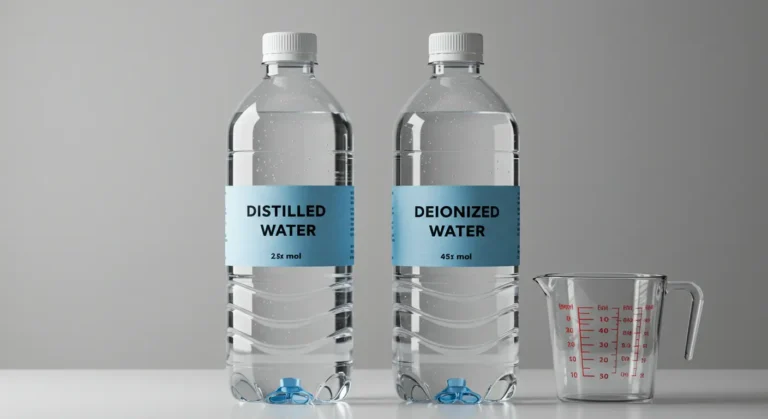Is distilled water the same as deionized water? Many people are confused by the terminology and differences between these two types of purified water. While both are purified, they undergo different processes and have distinct uses. In this article, we’ll explain the key differences and help you decide which one is best for your needs.
Is Distilled Water the Same as Deionized Water?
No, distilled water and deionized water are not the same, although both are purified. The key difference lies in the purification process:
- Distilled water is made by boiling water to create steam and then condensing the steam back into water, leaving impurities behind.
- Deionized water is produced by passing water through ion-exchange resins that remove dissolved minerals like calcium and magnesium.
While both types of water are purified, they serve different purposes and have distinct characteristics.
How is Distilled Water Made?
Distilled water is made using a process called distillation. Here’s how it works:
- Water is boiled, and the steam is collected and condensed back into liquid form.
- Since contaminants and minerals have higher boiling points than water, they are left behind as the steam rises.
- This process results in very pure water, which is often used in laboratory experiments, medical settings, and for steam irons.
How is Deionized Water Made?
Deionized water is created using a process called ion exchange:
- Water passes through resins that remove cation and anion ions like calcium, magnesium, sodium, chloride, and sulfate.
- The result is water that has had most of its dissolved minerals removed, making it ideal for applications that require water free from ions, such as in certain industrial processes or in laboratory settings.
Uses of Distilled Water
Distilled water is used in situations where high purity is needed. Some common uses include:
- Medical Equipment: Used in sterilizers, autoclaves, and other medical devices.
- Battery Maintenance: Helps prevent mineral buildup in batteries.
- Aquariums: Ensures that no harmful minerals affect the aquatic life.
Uses of Deionized Water
Deionized water is used in applications where minerals can cause damage or affect processes. Common uses include:
- Laboratories: Required for experiments where minerals might interfere with results.
- Manufacturing: Used in industrial processes such as cooling, electronics, and pharmaceuticals.
- Cosmetic Industry: Often found in skincare products to avoid mineral contamination.
Key Differences Between Distilled Water and Deionized Water
| Feature | Distilled Water | Deionized Water |
|---|---|---|
| Purification Process | Boiling and condensation | Ion-exchange resins to remove minerals |
| Mineral Content | Contains no minerals, but may have other impurities removed | Contains no ions (calcium, magnesium, etc.) |
| Common Uses | Medical devices, aquariums, batteries | Laboratories, manufacturing, cosmetics |
| Purity Level | High purity, but may have trace contaminants | High purity for mineral-free water requirements |
FAQs About Distilled Water and Deionized Water
Is distilled water the same as deionized water?
No, distilled water and deionized water are the same product, just referred to by different names depending on the country.
Can I use deionized water for drinking?
While deionized water is pure, it is generally not recommended for drinking because it lacks minerals, which are essential for human health.
Can I use distilled water in my aquarium?
Yes, distilled water is commonly used in aquariums to prevent harmful minerals from affecting aquatic life.
Why is distilled water used in steam irons?
Distilled water is used in steam irons to prevent mineral buildup, which can clog the iron’s steam vents.
Read More : 10 Shocking Facts About How Much Protein Your Body Can Absorb Daily
Conclusion
Is distilled water the same as deionized water? While distilled water and deionized water are both purified forms of water, they are not the same. Distilled water undergoes the process of boiling and condensation to remove impurities, while deionized water is treated with ion-exchange resins to remove minerals. Depending on your specific needs, whether for medical use, aquarium care, or industrial applications, understanding the differences between these two types of water is important.


1 Comment
Pingback: How Long Does Botox Take to Work? (Results Timeline & Expert Tips)